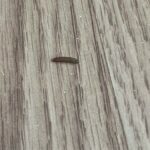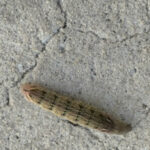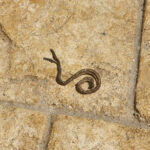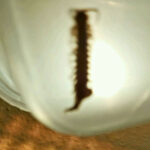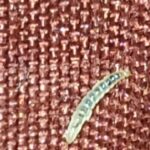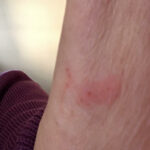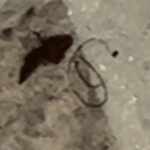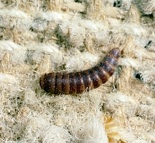
“What kind of worm is this?” asks Harriet in her submission regarding the black creature pictured below. “I found them on my patio after watering and I have a picture.” We think the worm Harriet found is not a worm at all, but a cutworm, albeit a very young one at that (given the size). Cutworms are caterpillars of the cutworm moth. They are notorious agricultural pests, as they come in large droves and kill plants. The way they do this is by munching through the stems of the plants, thereby cutting them down (hence the name). If their populations are big enough, they can even eliminate entire fields of crops.
Unfortunately, cutworms are also garden pests, and we assume that Harriet was “watering” plants on her patio, or in her garden. If she found them in houseplants, they would be easier to manage. She can just replace the soil and spray the plants with some soapy water to make it harder for the caterpillars to get a grip on the plant. That said, if she has a garden, and she is finding cutworms in her garden, she might find it more difficult to control and eliminate an infestation of them. The best way to control their populations is to keep one’s plants free of organic debris like fallen leaves and twigs. Likewise, creating barriers around one’s plant might help prevent the spread of an infestation. Although the cutworm moths will typically lay their eggs directly on the plant or in the soil, the infestation still spreads via roaming caterpillars, so if Harriet can isolate the cutworms to only a few plants, they will be easier to manage. Make sure that the barriers go all the way into the soil, so as to stop cutworms that are travelling via the soil from reaching the plant.
Under no circumstances do we recommend using pesticides. They are very toxic not only to caterpillars, but also to humans or animals. Even if the plants she is growing in her garden are not fruits or vegetables, and will not be consumed by her or anyone else, other animals that live in the soil or that might munch on/lick the plants could be poisoned. There are some types of naturally-occuring bacteria one can purchase and use as a caterpillar-repellent, though we do not know enough about this to suggest it in good faith. If Harriet is considering using some type of bacteria, or other organic control, we advise that she do her own research, or perhaps that she consult a professional pest controller. Of course, if she only found one caterpillar, then there is not necessarily an infestation going on.
In conclusion, we think the critter Harriet found looks like a cutworm. These guys are infamous pests of gardens and farms, but they do not directly harm humans or pets, so Harriet needs not worry about that. We hope this helps, and we wish Harriet the very best!
All About Worms is always free, always reader-supported. Your tips via CashApp, Venmo, or Paypal are appreciated! Receipts will come from ISIPP Publishing.
You might also find these guys interesting!




